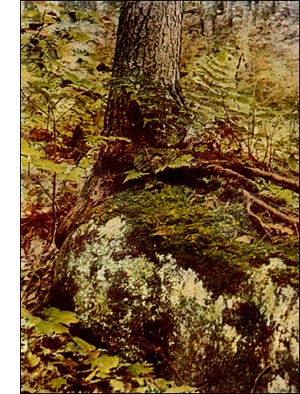Genus Frullania
 Genus FRULLANIA, Raddi
Genus FRULLANIA, RaddiThe plants are usually in shades of red or brown or even black, although sometimes green. They grow in delicate traceries over the bark of trees or rocks.
The stems are opaque and branched, each branch arising from the axil of a stem-leaf from which it is always free.
The upper leaves are alternate and are inserted somewhat obliquely. They are two-lobed, one lobe folded to lie over the other. The upper and larger is known as the lobe and the lower and smaller as the lobule.
The lobule, is an inflated water-sac, in shape resembling a helmet or hood or cylinder and often has at the base a tiny process (stylus).
The under leaves or stipules (amphigastra) are strongly twocleft and have often tufts of rootlets at their bases.
The male flowers (antheridia) are found on short branches either on the same plant with the female flowers (archegonia) or on separate plants.
The envelope of the flower (perianth) is free and exserted from the leaves. It is 3- to 4-angled and tipped with a short tubular beak (mucronate). The veil (calyptra) is free and included in the perianth. The spore-case is somewhat spherical on a stout pedicel 2 to 3 times longer than the perianth. It opens by four valves to eject its spores. There are about 150 species in all, which are well represented in both temperate and tropical zones; about twenty are found in North America.
The generic name Frullania was given in honour of Signor Leonardo Frullani, an Italian minister of state.
Frullania Eboracensis Lichen